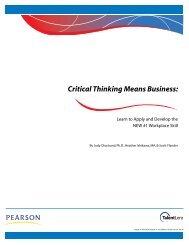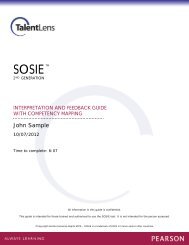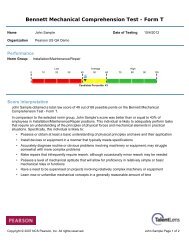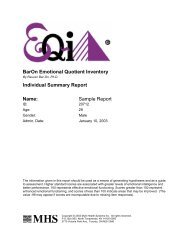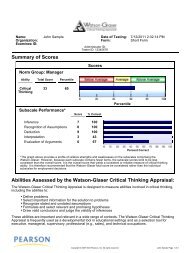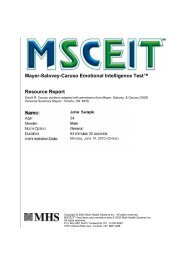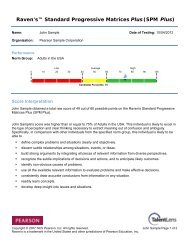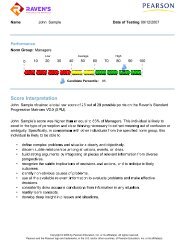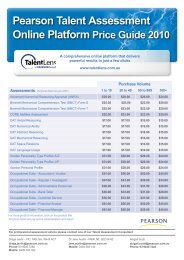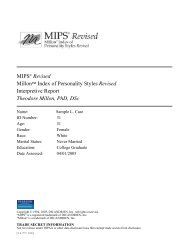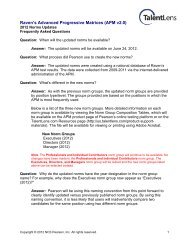You also want an ePaper? Increase the reach of your titles
YUMPU automatically turns print PDFs into web optimized ePapers that Google loves.
Response Style ExplainedIndicates the need for further examination – possible validity concernPARTICIPANT SUMMARYName: Harold High •Age: 32 •Gender: MName: Harold HighAge: 32Gender: MaleCompletion Date:Time to Completion: 5:32 mins (Unusually short response time)Norm Type: General PopulationINCONSISTENCY INDEX: 0The Inconsistency Index is 0, indicating consistency in responses across pairs of items measuring similar content.POSITIVE IMPRESSION: Could not be scored NEGATIVE IMPRESSION: 0The Positive Impression index could not be calculated due to omitted items. You may still want to clarify the approach that wastaken when completing the EQ-i 2.0. You may want to ask:“Tell me about your process for responding to the items.”“What did you think of the items? Were any particularly difficult to respond to?”“Why did you choose not to respond to certain items?The Negative Impression index is less than 3 indicating that responses were not likely the result of an overly negative responsestyle.ITEM 133 (My responses to the preceding sentences were open and honest): 5Harold’s response was: Always/Almost Always.OMITTED ITEMS: 1% overall omission rateAlthough there were a few missing responses, the overall omission rate is not a concern as it was relatively low and all scalescould be scored. Note. The Item Responses page displays which item responses were omitted.RESPONSE DISTRIBUTIONHarold tended to use the extreme ends of the scale.You may want to ask:“How did you go about answering the items?”“How have you used similar scales in the past?Do you tend to use the end-points of the scale?”2Copyright © 2011 Multi-Health Systems Inc. All rights reserved.245041820112.0
Overview of ResultsName: Harold High •Age: 32 •Gender: M70 90 100 110 130Total EI131Self-Perception Composite125Self-Regard respecting oneself; confidenceSelf-Actualization pursuit of meaning; self-improvementEmotional Self-Awareness understanding own emotions121124118Self-Expression Composite129Emotional Expression constructive expression of emotionsAssertiveness communicating feelings, beliefs; non-offensiveIndependence self-directed; free from emotional dependency129119119Interpersonal Composite127Interpersonal Relationships mutually satisfying relationshipsEmpathy understanding, appreciating how others feelSocial Responsibility social consciousness; helpful122123126Decision Making Composite120Problem Solving find solutions when emotions are involvedReality Testing objective; see things as they really areImpulse Control resist or delay impulse to act113117117Stress Management Composite132Flexibility adapting emotions, thoughts and behaviorsStress Tolerance coping with stressful situationsOptimism positive attitude and outlook on life13112812170 90 100 110 130Low Range Mid Range High Range3Copyright © 2011 Multi-Health Systems Inc. All rights reserved.245041820112.0
Well-Being IndicatorHappiness satisfied with life; content120Name: Harold High •Age: 32 •Gender: M70 90 100 110 130In the EQ-i 2.0 model, Happiness is different than the other EIabilities in that it both contributes to, and is a product of, EI.As such, your client’s result in Happiness can be used as abarometer of emotional health and well-being.Although the causes and factors related to an individual’shappiness extend beyond the scope of this assessment, it isimportant to examine your client’s Happiness result in relationto the other EI subscales. For example, would strengtheningLow Range Mid Range High Rangelower subscales lead to improved Happiness? Or will increasedHappiness stem from working within the client’s strengths andtalents? In either case, the best way forward is as unique toeach person as his or her own definition of Happiness.The four subscales most often associated with Happiness are:• Self-Regard • Optimism• Self-Actualization • Interpersonal RelationshipsHappinessThe result in Happiness suggests that your client almost always maintains a happy disposition towards all aspects of life.Your client enjoys the company of others and is likely on a positive life course. The client's happiness is seen and experiencedas infectious. The results in Happiness and the four subscales most connected with Happiness are high. Because of thisyour client likely experiences a certain balance between well-being, optimism, self-confidence, personal relationships andfulfillment of goals. Gains in one area likely contribute to gains in another—quite a reciprocal set of relationships! Your clientmay:• exude cheerfulness at both work and play.• be seen by coworkers as motivating and resilient in the face of obstacles.Self-RegardHappiness is a by-product of believing in oneself and livingaccording to your own values and standards. Your client’shigh self-regard helps to promote positive feelings aboutoneself, confidence, and enhanced life satisfaction andhappiness. You might ask:• If you could improve one facet of your life, whatwould it be? Why?• Aside from material things, what is it about you thatmakes you truly happy?OptimismIn the face of setback and disappointment, the ability torecover and claim a happy state is contingent on one'slevel of optimism. The results indicate that your client has ahigh level of optimism, adopting a positive frameworkduring adverse conditions. This approach to life enhancesand sustains pervasive feelings of happiness. You mightask:• What thoughts help you remain optimistic duringmore difficult times?• Are there any situations where you feel lessoptimistic? If so, how can you improve or deal betterwith those situations?Interpersonal RelationshipsThe Interpersonal Relationships result indicates that yourclient has well-developed relationships that likely helpreduce the negative effects of life’s daily demands. Ifmaintained, these relationships can enhance and sustainpervasive feelings of happiness. You might ask:• Are there times when you struggle with yourrelationships? If so, what causes the struggles andhow do you remedy conflict andmiscommunication?• Do you have a mentor? Do you act as a mentor tosomeone else?Self-ActualizationHappiness comes from a willingness to learn and grow ona journey aligned with personal values. Your client’s levelof self-motivation and feelings of an enriched life ultimatelydrive personal achievements and overall happiness. Youmight ask:• Are there areas in your work or personal life that youwould like to further develop? If so, how can theseendeavors mesh with your current lifestyle?4Copyright © 2011 Multi-Health Systems Inc. All rights reserved.245041820112.0
Balancing EIThis section shows three related subscales for each of thefifteen subscales on the EQ-i 2.0. Below, you will find examplesof feedback that you can provide to the respondent.• Where a greater than ( ) or less than ( ) sign is shown,the subscale scores are significantly different and furtherinvestigation into these imbalances is recommended.• When an equal sign ( ) is shown, the subscale scores arenot significantly different from one another and therefore arewell balanced. In order to maintain this balance, you maywant to guide the respondent to watch for significant growthName: Harold High •Age: 32 •Gender: Min one subscale over the other and consider ways that he/shecan develop the subscales in tandem.Please note that if you included this section in the respondent’sreport, the respondent will see only one subscale (therelationship with the greatest score discrepancy). All threerelationships are shown here so that you may debrief therespondent on other areas that are out of balance. In additionto what is displayed in this report, you may want to exploreother balances and imbalances in the respondent’s profile thatmay lead to further EI development.Your SelfRegard is in balance with your SelfActualization.Self-Actualization (124)Your SelfRegard is in balance with your Problem Solving.Self-Regard(121)Problem Solving (113)Reality Testing (117)Your SelfRegard is in balance with your Reality Testing.Your SelfActualization is in balance with your SelfRegard.Self-Regard (121)Self-PerceptionSelf-Actualization(124)Optimism (121)Your SelfActualization is in balance with your Optimism.Your SelfActualization is in balance with your Reality Testing.Reality Testing (117)Your Emotional SelfAwareness is in balance with your Reality Testing.Reality Testing (117)EmotionalSelf-Awareness(118)EmotionalExpression (129)Because Emotional SelfAwareness is lower than Emotional Expression, you may have atendency to express emotions more often than you take the time to fully understand them.This imbalance may result in the untimely expression of emotions, or expressing emotionswithout the appropriate rationale or reasoning.Because Emotional SelfAwareness is lower than Stress Tolerance, you may be betterable to cope with stress than you are able to understand or deal with the emotionsStress Tolerance (128) associated with stress. Your current approach to handling stress may be more actionoriented than it is about processing the emotions involved.5Copyright © 2011 Multi-Health Systems Inc. All rights reserved.245041820112.0
Balancing EIName: Harold High •Age: 32 •Gender: MFlexibility (131)Your Problem Solving is lower than your Flexibility. This imbalance suggests that you mayhave a tendency to continue to look for alternate solutions to a problem, even when youare well into implementing a solution. Although this tendency may prove beneficial fromtime to time, you run the risk of being inefficient over the longterm.Your Problem Solving is in balance with your Reality Testing.ProblemSolving(113)Reality Testing (117)Your Problem Solving is in balance with your Emotional SelfAwareness.Emotional (118)Self-AwarenessYour Reality Testing is in balance with your Emotional SelfAwareness.EmotionalSelf-Awareness (118)Decision MakingRealityTesting(117)Self-Regard (121)Your Reality Testing is in balance with your SelfRegard.Your Reality Testing is in balance with your Problem Solving.Problem Solving (113)Flexibility (131)Impulse Control is lower than Flexibility, suggesting that you are more flexible thanregulated. Although flexibility is an essential skill, it is important to remain open to newideas and change, though not at the expense of sound reason. You want to be flexible butnot to the point that changes are made haphazardly without proper thought to theimplications of the changes.ImpulseControl(117)Stress Tolerance (128)Your Impulse Control is lower than your Stress Tolerance. This profile indicates that youare able to manage the emotions of stressful situations better than you manage youractions. Combining coping strategies with a more deliberate and controlled behavioralstyle under stress can improve your overall performance.Your Impulse Control is in balance with your Assertiveness.Assertiveness (119)8Copyright © 2011 Multi-Health Systems Inc. All rights reserved.245041820112.0
Balancing EIName: Harold High •Age: 32 •Gender: MProblem Solving (113)Your Flexibility is higher than your Problem Solving. Your inclination to be flexible may attimes lead you to reflect or hesitate when making decisions. While it is good to be open tochange and to consider options, your effectiveness can be reduced if you end up gettingstuck making a decision or postponing action. The best decisions usually involve properconsideration of alternatives, and the ability to act when needed.Flexibility(131)Independence (119)Your Flexibility is higher than your Independence. This profile may make you susceptibleto being swayed by others and their decisions (a.k.a. groupthink). If you find yourselfappearing too compliant and easygoing, you could benefit from taking a stand when youbelieve something is important, even if your viewpoint differs from consensus.Impulse Control (117)Because your Flexibility is higher than your Impulse Control, you may be inclined to makechanges without giving an appropriate amount of thought to the change. Your behavior atwork may be affected more by the demands of the moment than by longer termconsiderations. Watch for others’ reactions to the changes you bring about. If they aren’ton board with your change, it may be a sign that your changes are likely more impulsivethan they are grounded.Problem Solving (113)Your Stress Tolerance is higher than your Problem Solving, which suggests that you feelmore able to deal with stress than to solve the underlying problem. Because of thisimbalance, you may want to be on the watch for fatigue and burnout in your life. Takeaction to solve problems even in situations where you feel you are able to copeadequately.Stress ManagementStressTolerance(128)Flexibility (131)Your Stress Tolerance is in balance with your Flexibility.Your Stress Tolerance is in balance with your Interpersonal Relationships.Interpersonal(122)RelationshipsYour Optimism is in balance with your SelfRegard.Self-Regard (121)Your Optimism is in balance with your Interpersonal Relationships.Optimism(121)Interpersonal(122)RelationshipsYour Optimism is in balance with your Reality Testing.Reality Testing (117)9Copyright © 2011 Multi-Health Systems Inc. All rights reserved.245041820112.0
Item ResponsesName: Harold High •Age: 32 •Gender: MResponses are shown by item on the following two pages.Items are shown by subscale and are exactly as theyappeared on the assessment. Please note, although someitems use reversed language, the higher the responseindicated, the more frequent is the behavior.Responses to each item were provided using thefollowing rating scale:1= Never/Rarely; 2=Occasionally; 3=Sometimes;4=Often; 5=Always/Almost Always.Note ? = Omitted ItemThis section of the report contains copyrighted items and information that are not intended for public disclosure. If it is necessary to provide a copy of thereport to anyone other than the assessor, this section must be removed.Self-Regard10 Looking at both my good and bad points, I feel goodabout myself.19 I feel sure of myself.31 I don’t feel good about myself.64 I lack self-confidence.89 It's hard for me to accept myself just the way I am.128 I think highly of myself.130 I respect myself.132 I'm happy with who I am.Self-Actualization8 I accomplish my goals.49 I feel I have something to contribute.58 I seek out enriching experiences.63 I am self-motivated.73 I make good use of my abilities.76 I strive to be the best I can be.104 I am driven to achieve.109 I try to make my life as meaningful as I can.118 I look for ways to improve myself.Emotional Self-Awareness16 I pay attention to how I'm feeling.27 I'm aware of the impact of my mood on others.40 I know what triggers my emotions.62 I'm aware of how I feel.105 I recognize when I'm upset.121 I understand how the emotions of others affect me.125 I know which emotions affect my performance.551115555545555552554555Independence4 It’s hard for me to make decisions on my own.15 I cling to others.46 I am easily influenced by others.54 I prefer a job in which I'm told what to do.65 It's hard for me to do things on my own.81 I need reassurance from others.97 I need other people more than they need me.114 I am more of a follower than a leader.Interpersonal Relationships9 It’s easy for me to make friends.22 I enjoy talking with people.38 I am easy to approach.41 People confide in me.66 I am fun to be with.74 I'm a team player.102 People think I am sociable.129 I have good relationships with others.Empathy13 I'm aware of how others feel.24 I am empathic.30 I am good at understanding the way other people feel.52 I avoid hurting the feelings of others.70 I'm in touch with other people's emotions.78 I relate to the emotions of others.91 I respect the way others feel.110 I am sensitive to the feelings of others.124 I care about other people's feelings.2211111155545555455545555Emotional Expression39 It's hard for me to share my feelings with others.47 It's easy for me to express my feelings.69 It’s hard to express my intimate feelings.93 When I'm sad, I talk to people about it.100 I find it difficult to show people how I feel about them.103 I find it difficult to show affection.108 It’s hard for me to describe my feelings.117 It’s hard for me to smile.Assertiveness3 I back down even when I know I am right.7 I say "no" when I need to.21 I am assertive without being offensive.23 When I disagree with someone, I say so.53 I am firm and direct when necessary.86 I stand up for what I believe in.95 I tell people what I think.151511211255455Social Responsibility11 I act in an environmentally friendly way.18 I try to make a difference in society.20 I like helping people.60 I am a contributing member of the groups to whichI belong.61 I contribute to my community.115 I care about social issues.Problem Solving17 When I'm really upset, I can't decide what to do.37 I tend to worry about a problem rather than trying tosolve it.45 I avoid dealing with problems.68 It’s hard for me to decide on the best solution whensolving a problem.455555113110Copyright © 2011 Multi-Health Systems Inc. All rights reserved.245041820112.0
Follow-up QuestionsName: Harold High •Age: 32 •Gender: MThe following questions are suggested to probe further into your client’s results.Questions are listed by subscale.Self-Regard1. What do you believe are your strengths? Provide an example where you used your strengths to your advantage.2. Which of your abilities require development? Provide an example where you have had to work around/compensatefor an area of weakness.3. Describe a situation where you had to overcome feelings of insecurity or low confidence in your abilities.4. Tell me about a time when it was clear you had made a mistake or error. How did you feel and what actiondid you take to rectify the situation? Why do you think you felt this way?5. How can you use your strengths to achieve more of your goals (personal or job performance)?How can you overcome weaknesses on the way to achieving your goals?6. What are you willing to do to improve your skills, abilities, habits, and attitudes?Self-Actualization1. What are some of your interests outside of work?2. Can you describe 1 or 2 of your short-term goals? Long-term goals? How are your short-term goalsconnected to your long term-goals?3. Tell me about your process for setting goals? How would you describe the goals you set for yourself?4. What new activities or interests would you like to explore?5. How do you make time to do things you truly enjoy? What are some of the benefits both you andyour career receive from these activities?Emotional Self-Awareness1. How do your emotions affect other people? Can you provide an example where your teamwork(or a relationship) was affected by the way you were feeling?2. What things do you feel really happy about? Sad? Angry? Describe how you experience theseemotions physically, behaviorally, cognitively.3. Describe a time when you were making a decision and your emotions got the best of you?What emotion were you experiencing and what was your reaction?4. What emotions help your job performance? Which emotions hinder your performance?5. Are there emotions that you are more comfortable with than others? Why do you think that is?Emotional Expression1. Are there some emotions you feel more comfortable expressing than others? Why do you think that is?How do you express what you are feeling? Give examples?2. Describe a time when you regretted not having expressed your true thoughts or feelings about something.What were the consequences (positive and negative) of not expressing your feelings? How would the situationhave been different had you been more expressive?3. In general, do you find yourself bottling up emotions? How does this affect your ability to get your work done?4. What does being happy look like to you? Being angry? Being frustrated?5. Have others ever misread your feelings or thoughts? Why do you think that happened?Assertiveness1. Describe a scenario in which you behaved assertively. What specifically did you do or say that was assertive?2. What do you find challenging about being assertive? What is it about the context or situation that makes youuncomfortable standing up for yourself?3. How would you react if someone on your team consistently failed to pull their weight on a team project?4. What is the difference between assertive and aggressive behavior? Have you ever been perceived as being aggressive?How do you know?5. Tell me about a time when you disagreed with someone. What did you do/say and what was the outcome?12Copyright © 2011 Multi-Health Systems Inc. All rights reserved.245041820112.0
Follow-up QuestionsName: Harold High •Age: 32 •Gender: MIndependence1. Describe your typical style for making decisions.2. Can you give an example of when you relied on others to make a decision for you? What was the outcome?3. What feelings do you experience when you need to work independently from others?Do these feelings change (i.e., become more or less intense) over time?4. To what extent do you involve others in the decisions you make?5. Can you describe a situation where you went against the grain and made a decision that was not the popular choice?What was the outcome?Interpersonal Relationships1. Describe a time when you had to mediate a conflict between team members. Describe a time when you had to deal with aninterpersonal conflict with a team member. How did your emotions differ between experiences?2. What efforts do you put in to maintaining healthy and effective relationships at work?How do you know when a working relationship is effective?3. Describe what types of social situations make you feel uncomfortable. What is your typical response in these situations?4. Tell me about a time when you had to put extra effort into maintaining a close relationship.What value did this relationship have in your life?5. Has there ever been a time when your relationships have made it difficult to make a decision or get your work done?Empathy1. Tell me about a time when it was really important that you were able to understand the way someone else felt.How did you convey this understanding? How did you ensure you understood them?2. Describe a situation where you were not as sensitive to someone’s feelings as you should have been.Why do you think this was the case? What could you have done differently?3. In your opinion, what is the difference between sympathy and empathy? How do you ensure you display these differently?4. How do you ensure you have really understood how another person is feeling?5. Describe a situation where you found it difficult to make a decision because of the way the outcome might impact others.What was the result of your decision?Social Responsibility1. What have you done recently to help those in need?2. Describe a situation where you have placed others’ needs/interests over your own.How often does this type of scenario occur in your life?3. How do you define “being a team player” in your job? What are some examples of where your successcan be attributed to your team and not to you alone?4. What social issues are of particular concern to you? How do you contribute to these causes?5. Provide an example of when you had to take responsibility for your actions. How did this make you feel?Problem Solving1. What was one of the most challenging problems you have ever had to solve?Describe the problem-solving process you used to arrive at the solution.2. How do you think your problem-solving process looks to those you work with?What would they say are strengths of this process? What would they say you could do better?3. Describe a time when your emotions hampered your ability to make a decision. Why did you get sidetracked?4. What role do your emotions play in your problem-solving process? How do they help or hinder your ability to arrive at a solution?5. Tell me about a time when you made a rash decision. What caused this to happen and how did it affect others?Reality Testing1. Would you describe yourself as a realist or an idealist? How does this description manifest itself in your job?2. Describe a time where you incorrectly sized up a situation. What information did you misjudge and what was the impact?3. How would others describe the goals you set? What information do you take into account when you set these goals?4. Tell me about a time when you should have been more objective rather than relying on a “gut feeling”.How do you confirm that your “gut feeling” is accurate?5. Tell me about a time when you should have listened to your instincts rather than being so objective. How do you confirm thatyour instincts are reliable?13Copyright © 2011 Multi-Health Systems Inc. All rights reserved.245041820112.0
Follow-up QuestionsName: Harold High •Age: 32 •Gender: MImpulse Control1. How do you typically deal with an impulse to act?2. Tell me about a time when you had to exercise patience and control over your behavior.3. Describe a situation where you were impatient and reacted hastily. How did this impact the end result?4. Describe a situation where it was beneficial for you to act quickly. How did this make you feel?5. Has your impulsiveness ever created problems for you? How do you think others view your behavior in these instances?Flexibility1. Would others say that you are flexible and open to change, or rigid and set in your ways?What benefits and drawbacks does your typical style bring to your workplace?2. How do you successfully manage change in an environment where people are hesitant todepart with their old ways of doing things?3. Give an example of where you found it difficult to adjust to a change in your job. What emotions were you feeling?4. Do you prefer your work to be predictable and stable, or do you enjoy conditions that require you to change what you do?5. Describe a time where you have to adjust quickly to changes in your environment.What was your process for changing your behavior/tasks?Stress Tolerance1. How do you tackle stressful circumstances at work? What is an example of where you had tomanage stress in order to get your job done?2. What circumstances are stressful for you? How do you proactively manage these circumstancesin order to reduce the stress you experience?3. How does stress manifest itself in the way you feel (i.e., emotionally, physically) or act?Can you detect the very onset of stress in your body?4. What strategies do you use to cope with stress? How much do these strategies rely onsupport from others?5. Describe a time when it was important for you to remain calm under pressure.What skills or techniques did you use? How were others impacted in this situation?Optimism1. Would you describe yourself as having positive or negative expectations about how things will turn out?How does this impact the way you set goals and objectives?2. Describe a project/task where you experienced several setbacks. What was your approach to overcoming these difficulties?3. When planning and setting goals, how do you manage risk? What does your contingency plan look like?4. Describe a situation where you were overly positive or overly negative in your expectations about how things would turn out.What impact did your outlook have on your performance and that of others?5. What are some resources or strategies you draw upon in order to stay positive about the future?14Copyright © 2011 Multi-Health Systems Inc. All rights reserved.245041820112.0
Action PlanName: Harold High •Age: 32 •Gender: MThe steps your client takes towards achieving his/her EI goals will determine whetheror not success is realized. Use this step-by-step activity plan to help guide your clienttowards accomplishing personal objectives. Remember to use the SMART goal settingcriteria for each goal.Write down up to three EI skills or behaviors that require further development (e.g.,“reflective listening” to build empathy, or “recognizing how my body reacts to stress”to raise emotional self-awareness). The SMART goals should then help to strengthenthese EI skills and behaviors.SPECIFICMEASURABLEACTION-ORIENTEDREALISTICTIMELY1.2.3.Write down up to three overall qualities that your client would like to have (e.g., integrity,providing clear leadership, team player, clear communicator). In some way the SMARTgoals he/she outlines in this action plan should help to achieve these qualities.1.2.3.Transfer your client's SMART goals into the action plan template below.SMARTGoalTime Frame Benefits Measure of SuccessSupport andResources NeededPotential BarriersListen toothersIn teammeetingsStarting fromtodayOther people willlisten to meI will get to heareveryone’s viewsFeedback from theteam to say that I amlistening to them moreTake actions thatother people havesuggestedFrom the team togive me honestfeedbackTime - often do not havetime to listen to viewsbut just need to give instructions.If this is thecase need to tell peopleat the beginning of themeetingAction Planner (example)I commit to this action plan .(signature)15Copyright © 2011 Multi-Health Systems Inc. All rights reserved.245041820112.0
EI Development CommitmentName: Harold High •Age: 32 •Gender: MA Development Commitment is a tool to help hold yourclient accountable for accomplishing the goals outlinedin his/her action plan. As we all too often know, ourplans for personal growth and development often fallby the wayside when we get back to work and ourorganization's demands win the competition for timeand attention. By outlining your client’s objectives here,and ensuring that your client does the same in his or herreport, you help your client to be more accountable toreaching their professional objectives.My Client’s Development GoalsMy client’s action plan includes the following goals:Due Date1.2.3.4.Your SignatureYour Client's Signature16Copyright © 2011 Multi-Health Systems Inc. All rights reserved.245041820112.0
Coach’s Guide to an EQ-i 2.0 Debrief SessionPreparing for the DebriefReview the Reporto Review the Response Style Explained page and look into any flagged areas.o Review the Total EI score and composite scores. Where does the client fall in relation to the general population?o Review the individual subscales and patterns. Which particular combinations of subscales are striking to you?Which do you want to investigate at the item level?o Review item scores for any particularly high or low scores.o Examine the Balancing EI page. What stands out in this client’s results? Which subscales do you need to look atmore closely? What might be some challenges associated with the results?o Make notes on areas you are curious about.Conducting the DebriefName: Harold High •Age: 32 •Gender: Mo What is your overall impression? What will you want to keep in mind as you go through the debrief?Phase Points to Keep in Mind Questions to Ask1. Build RapportThe first step is tocreate a sense ofease and establishcommon goalsbetween you andyour client.2. Validate FactsNext, establishthe “truth” of EQ-iresults in the eyesof your client.o Explain how the feedback will bestructured and how long it will take.o Ask what the client wants to get out of thesession.o Remind the client of the confidentialityagreement and who “owns the data”.o If appropriate, show the client a samplereport so that they are prepared for whatthey will be seeing in their own report.This may help them understand what theresults will indicate before they actuallysee them.o Remind the client that this is a self-reportand that it is a “snapshot in time”. It is astarting point for discussion, not the end ofthe investigation.o Give definition of EI and recap details ofthe EQ-i 2.0.o As you can see, the bars represent howyou responded to the items on each scaleof the EQ-i 2.0.o The bars that are in the middle range showthat compared to the general population,you answered the items in a similar way.o Bars to the left indicate decreased use ofbehaviors related to the scale.o Bars to the right indicate increased use ofbehaviors related to the scale.o How are you feeling about this meeting?o What was your experience in taking theassessment? Probing questions: were youalone, did you do it at the beginning of the day,end of the day; do you recall any items that youhad difficulty with or that were not clear to you?o Is there anything significant going on inyour life that may have affected how youresponded to the items?o How did you find the items themselves?Anything you found odd or curious?o Do you have any questions or commentsbefore we go over your profile?o What is your first impression of this profile?o Does this profile look accurate to you?o What surprises you?o Where would you like to focus first?o What questions do you have about yourresults?o Can you give me an example of how you usethat skill?o Would you say this is a real strength of yours?o This suggests to me that ____. Is that trueof you?17Copyright © 2011 Multi-Health Systems Inc. All rights reserved.245041820112.0
Name: Harold High •Age: 32 •Gender: MCoach’s Guide to an EQ-i 2.0 Debrief SessionPhase Points to Keep in Mind Questions to Ask3. DiscoveryIn the third step, thegoal is to acquire afull understanding ofany challenges thatmay be present. Asa coach, you wantto probe for detailsto clarify your client’sthoughts, feelings,opinions, and expectations.4. EstablishRelevanceNext, activate interestin finding a solutionand gauge thepossibility and desirefor change.5. Explore BenefitsThe goal here is tohelp your client becomeaware of thebenefits of changeby considering thebenefits of a particularsolution.6. TransitionThe last part of thesession involves discussingnext stepsand establishing theclient’s commitmentto continue workingwith you.Use the Follow-UpQuestions pages to get abetter understanding of howyour client demonstratesthe skills related to specificsubscales.Connect the importance ofyour conversation to yourclient’s work.Pose hypothetical, jobrelatedsituations to helpyour client imagine a newstate of behavior and itsoutcomes.“If… then” questions help theclient project an ideal state ofoperating effectively.Ask transition questions toremind your client of timelimitations to ensure themajority of areas you bothwant to discuss are addressed.“How” questions help workout the logistics of yourfuture relationship.If appropriate, complete theDevelopment Action Plantogether with your client.o What areas stand out for you as things you’d like to focus on?o How satisfied are you with that?o What concerns do you have with that situation?o Why do you think that is so?o What is the message here?o What gets in your way in this area?o Why is that so frustrating?o How do you see that contributing to your success?o How do you see that holding you back?o Do these areas interfere with achieving your goals in any way?o How might a decreased use of these types of behaviors helpyou in your role?o It sounds like it is important for you to ___ on the job. Is thatcorrect?o How long have you been doing that?o To what extent is that effective for you?o How is that behavior working for you?o What is the ideal situation here?o If you had a choice, what would you do?o If you didn’t have to deal with ____, how would things bedifferent?o What kind of support would be helpful?o If you were going to work on one or two areas, which one(s)would you choose?o What benefits would you like to achieve by improving inthose areas?o It sounds like this is an area you’d like to work on. What are someways that you might be able to further develop in this area?o What is one thing you can do to further develop this skill?Questions to help close the conversation:o How would you like to move forward?o How committed are you to your development plan?o If you’re not completely committed, what do you need todo to get there? OR What do you need to change in yourdevelopment plan in order to be fully committed?o How will you remain accountable for developing in this area?o I propose that we ____. Does that sound good to you?o What outstanding questions do you have?18Copyright © 2011 Multi-Health Systems Inc. All rights reserved.245041820112.0



